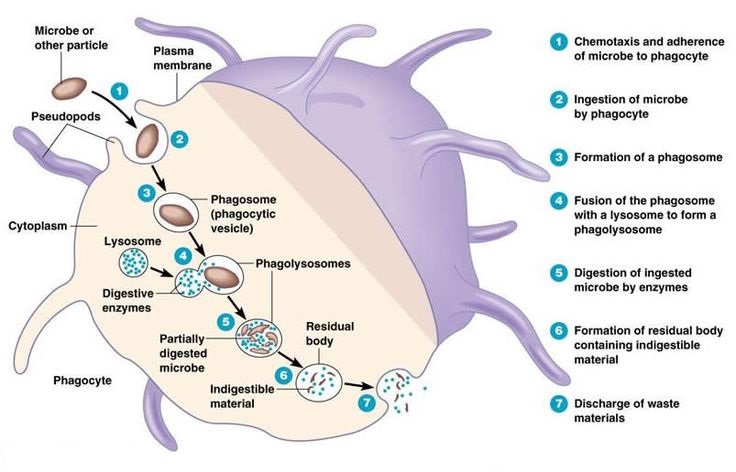
- The ingestion and digestion of exogenous antigens, such as whole microorganisms and insoluble particles and endogenous matter, such as injured or dead host cells, cellular debris etc. by phagocytes is called phagocytosis.
- It is an important defense mechanism of the host and is a type of endocytosis.
- Most of the bacteria that enter into the host are killed by different types of phagocytic cells such as neutrophils, macrophages and monocytes.
- The mononuclear phagocytic system consists of monocytes (circulating in the blood) and macrophages (in different tissues).
- Intestinal macrophages (in the gut), alveolar macrophages (in the lung), histiocytes (in connective tissues), Kupffer cells (in the liver), mesangial cells (in the kidney), microglial cells (in the brain) and osteocytes (in bone) are few examples of tissue macrophages.
Sequential steps in phagocytosis:
- The antigen (bacterial cell) first adheres to the cell membrane of the macrophage (phagocyte):
- Complex antigens such as whole bacterial cells and viruses adhere well and are readily phagocytosed.
- Isolated proteins and encapsulated bacteria are less readily phagocytosed because of their poor adherence.
- Sometimes antibody functions as opsonin and binds to the antigen and the phagocyte, making antigens more susceptible to phagocytosis, the process termed as opsonization.
- Phagocyte extends pseudopodia around the adhered material and engulfs it:
- Adherence induces the protrusions (pseudopodia) of the phagocyte cell membrane.
- Pseudopodia gradually increase in size and finally fuse together so that the bacterial cell is engulfed in the form a membrane-bound structure called a phagosome.
- Formation of a phagolysosome:
- Phagosome moves towards the lysosome and then fuses with it to form a phagolysosome.
- Hydrolytic and digestive enzymes that are present inside the lysosome digest the engulfed material.
- Elimination of the digested contents:
- The digested contents are absorbed into the surrounding cytoplasm if needed otherwise the residues are excreted outside the cell by the process of exocytosis.

source: https://www.pinterest.com/jmarsh758/phagocytosis/
Killing of ingested bacteria during phagocytosis includes two mechanisms:
- Oxygen independent mechanism:
- In this case, ingested bacterial cell is killed by the hydrolytic and digestive enzymes of the lysosome.
- Oxygen dependent mechanism:
- It is the most common mechanism of killing the antigen.
- During phagocytosis, phagocytic cell increases the intake of oxygen.
- At the same time, rate of pentose phosphate pathway increases to generate more NADPH which is a reducing agent.
- It then reduces, molecular oxygen to produce various toxic oxygen metabolites such as hydroxyl free radical, hydrogen peroxide and superoxide ion.
- These metabolites then kill the ingested bacteria and the process is called ‘respiratory burst’.